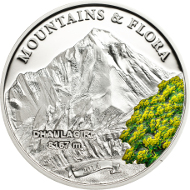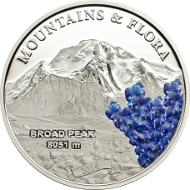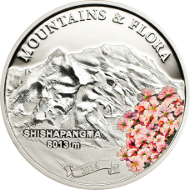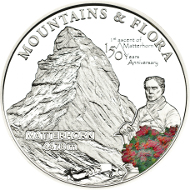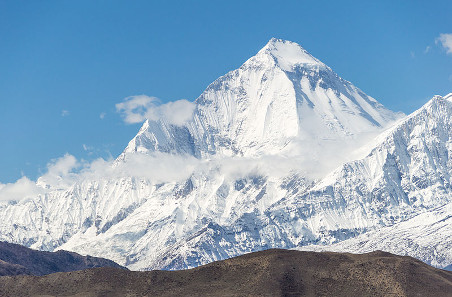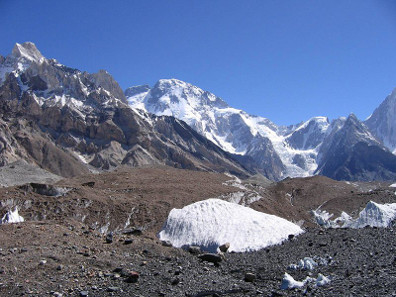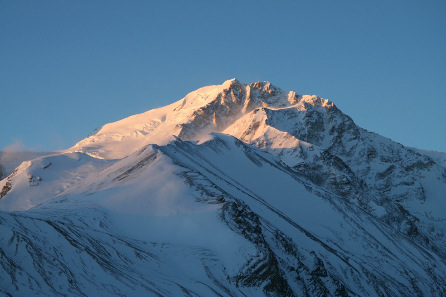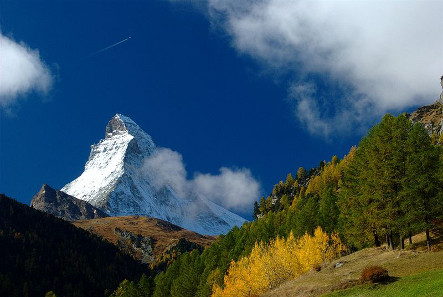August 20, 2015 – The world’s most imposing mountain ranges inspire awe and wonder. In return, Palau dedicates their popular Mountains & Flora series, produced by Coin Invest Trust, to these wonders of nature. As colorful as ever, the latest four creations inspire a feeling of awe and a rush of adrenaline in the beholder.
Palau / 5 Dollars / 2014 (Dhaulagiri, Broad Peak, Shishapangma) and 2015 (Matterhorn) / Silver .925 / 20 g / 38.61 mm / Mintage: 2500.
The obverse of all coins depicts the coat of arms of the issuing state Palau as well as a canoeist in an outrigger canoe. Above, the name of the country, REPUBLIC OF PALAU, below, the nominal value, 5 $. All coins’ reverses are designed the same way: below the logo of the MOUNTAINS & FLORA series, they show a mountain and a plant (in color) that is characteristic of the region. In front of the mountain its name and height are stated, as is the year of issue.
The Dhaulagiri in the Himalayas. Photograph: Wikipedia / Solundir. https://creativecommons.org/licenses/by-sa/3.0/deed.en
“White Mountain” is what the Nepalese call Dhaulagiri, the central mountain of the Dhaulagiri massif in the Himalayas. At 8617 m, the Dhaulagiri ranks seventh highest mountain in the world today. When it was measured in 1809, however, Lieutenant William Spencer and Captain John Hodgson arrived at a height of 8190 m. This made the Dhaulagiri not only the first discovery of an eight-thousander ever, but also the world’s highest peak, at least until the Kangchenjunga, also in the Himalayas, was discovered in 1838.
The Broad Peak on the border of Pakistan and China. Photograph: Wikipedia / Svy123. https://creativecommons.org/licenses/by-sa/3.0/deed.en
Broad Peak, part of the Karakoram mountain range on the border of Pakistan and China, consists of three summits at once. The mountain owes its name “Broad Peak” to explorer William Martin Conway, leader of an English expedition in 1892. He was referring to the mountain ridge which runs almost level over 1.5 km. At 8051 m above sea level, Broad Peak is the world’s 12th highest mountain.
The Shishapangma in Tibet. Photograph: Wikipedia / Dirk Groeger. https://creativecommons.org/licenses/by/2.0/deed.en
The summit of the Shishapangma rises up 8013 m in the Tibet Autonomous Region. Not only is it “the smallest” of the world’s eight-thousanders, it was also the last one to be climbed, with the first ascent completed in 1964 by a Chinese team.
The Matterhorn in Switzerland. Photograph: Wikipedia / Gamma Cygni. https://creativecommons.org/licenses/by/2.0/deed.en
By then, the first ascent of the Matterhorn in the Swiss-Italian Alps was almost nearing its 100th anniversary. On 14 July 1865, an expedition led by Englishman Edward Whymper succeeded in conquering the Swiss landmark with the unique silhouette. In 2015, this date will celebrate its 150th anniversary. During all this time, the massif has continued to fascinate people and attract many alpinists year after year. In spite of its moderate height of “just” 4478 m, the Matterhorn is anything but an easy ascent: To date, no less than 500 mountaineers have lost their lives in the attempt to reach the summit.
More information on these and other coins created by CIT are available on the website of Coin Invest Trust.
A wealth of information on all eight-thousanders is provided here.
If you ever wondered what makes people climb summits just watch this YouTube movie.
Have your own interactive summit experience with this feature of the Neue Zürcher Zeitung about Chasing the Matterhorn.





